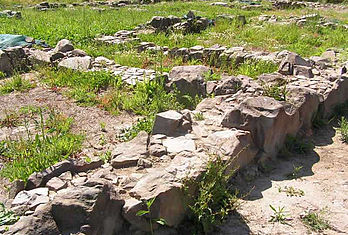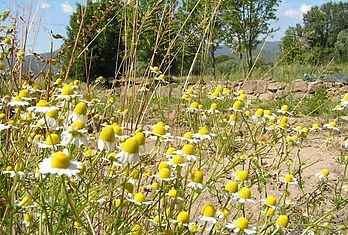The Archaeology in Capannori
Testo disponibilità:
Once people thought that in our territory there were not relevant archaeological evidences. In reality, there are many remains that date back to a vast span of time and have an important value due to the extention and the complex orography of our municipality. This is a microchosm that embraces different realities that have changed during the years mainly derivating from the changes of the geographical conditions (caused by the complex historical modifications related to the Serchio river).
During the years, excavations have been made that have lead to discover a vast presence of ancient civilizations on the territory of Capannori. This has also made possible a further researches regrading the landscape and the territory and its peculiarities.
Via dei Martiri Lunatesi - Capannori
Visits under reservation are available in spring, summer and autumn.
The site has been discovered in 2004 during the clearing of the ditch in via dei Martiri Lunatesi, in the centre of Capannori and behind the town hall. In the following years, excavations have been regularly made and an important roman settlement has been dug up.
The site, populated from ancient time (4th-5th century b.C.), had its period of major splendour between 100 and 250 b.C., when a little building built in the 1st century b.C. on a hill along the minor branch of the ancient Auser had been enlarged and fortified so to create a complex multifunctional structure that, according to recent excavations, probably was a guest house or an inn (taberna itineraria). It is made of rooms located on a line from east to west and organized on a threefold partition: in the west area there was a fenced courtyard where the smiths worked; the central area of the structure was used as a store for cereals and amphorae and as a common space for other activities; in the east area there was a public hall provided with a kind of heating system and walls covered in cocciopesto (smashed bricks). The remnants of a meal (the puls, a kind of cereal and legumes polenta that was the main dish in the ancient alimentation) have been discovered in this hall, suggesting its function of dining hall: tabernula.
In the east area there was a kind of covered courtyard that looked over the countryside (from north to south) and was probably used as goods yard or rest area for carts and animals.
Of great interest is the reconstruction of the original disposition of the territory where the site rises: a few hundred metres next to the site and toward east ran a branch of the Auser river and toward south there was the Via Cassia. The site is located in an area called Quarto Miglio where, allegedly, rose an imposing village: the Roman Capannori.
Roman farmhouse of "Palazzaccio" - S. Ginese di Compito
No visits allowed.
Excavations, began between 1987 and 1990, have been resumed in 2001 after a long interruption. From 2005 the research activity has been carried out in collaboration with the Universities of New York and Syracuse of Florence and the University of Asheville, North Carolina.
After ten years of excavations the history of the site begins to emerge. Populated by Etruscan, the site has been regularly occupied after the foundation of the settlement of Lucca in 180 b.C., when a farmhouse was built along one of the branches of the Auser, in the eastern area. The farmhouse had a productive section with machineries for the squeeze of grapes (pars rustica) and a residential section where the owner's family lived (pars urbana).
Life in the farmhouse had a non-common continuity and there are evidences of it having been restored many times, very likely up to the middle Ages.
Roman / Ligurian Sepulchre - Gragnano
Findings are exposed in the permanent archaeological Exposition of Capannori.
Discovered in November 1990 after road works, the site consists of two or three sepultures with ashes and grave goods stored into Greek-Italic amphorae. The findings are supposed to be attributable to Ligurian mercenaries paid by Romans. Materials have been damaged by the acidity of the ground and by the road works made before the excavations.
Domus / Farmhouse of Tosso - S. Margherita
No visits allowed. Findings are exposed in the permanent archaeological Exposition of Capannori.
In 2002 and 2003 the site has been subject of archaeological investigations that have permitted the exploration of a part of the multilayered building structure of great interest. The exploration has not been completed yet.
The first layer dates back to the end of the 1st century b.C., while a residential building dates back to the early imperial age. Its stonework structure presents the typical decorative and architectonic features of the domus, emblematically represented by the beautiful fragments of painted plasters discovered during the excavation.
After the end of the I century and during the middle imperial age, the "domus" was used as farmhouse and well preserved machineries for the squeeze of grapes (calcatorium) and for the collection of must (lacus). have been discovered. The building was abandoned in the late antiquity.
Investigation in the parsonage of Capannori - Capannori
No visits allowed. Findings are exposed in the permanent archaeological Exposition of Capannori.
In 1997 and 1998 the Archaeological Group of Capannori has investigated inside the parsonage of Capannori and in the adjacent kitchen garden. During the survey has emerged a complex stratification made of plastered walls and overlying floors along with evidences of the fusion of the bells in loco.
Dark Ages Necropolis - Vorno
No visits allowed. Reconstruction of a sepulture in the permanent archaeological exposition of Capannori.
Next to the parish of Vorno, in via di Valle, Dark Ages sepultures have been discovered. The tombs were empty and both directly buried in earth and located into lithic coffins, disposed on different layers.
Roman crossroad and probable rests of a mansion in Frizzone - Capannori
No visits allowed.
During road works, in Frizzone, archaeological findings related to an ancient crossroad have been discovered. The crossroad linked a consular street that ran from east to west, probably the ancient Via Cassia, and a minor street that ran from north to south and was probably flanked by a building.

